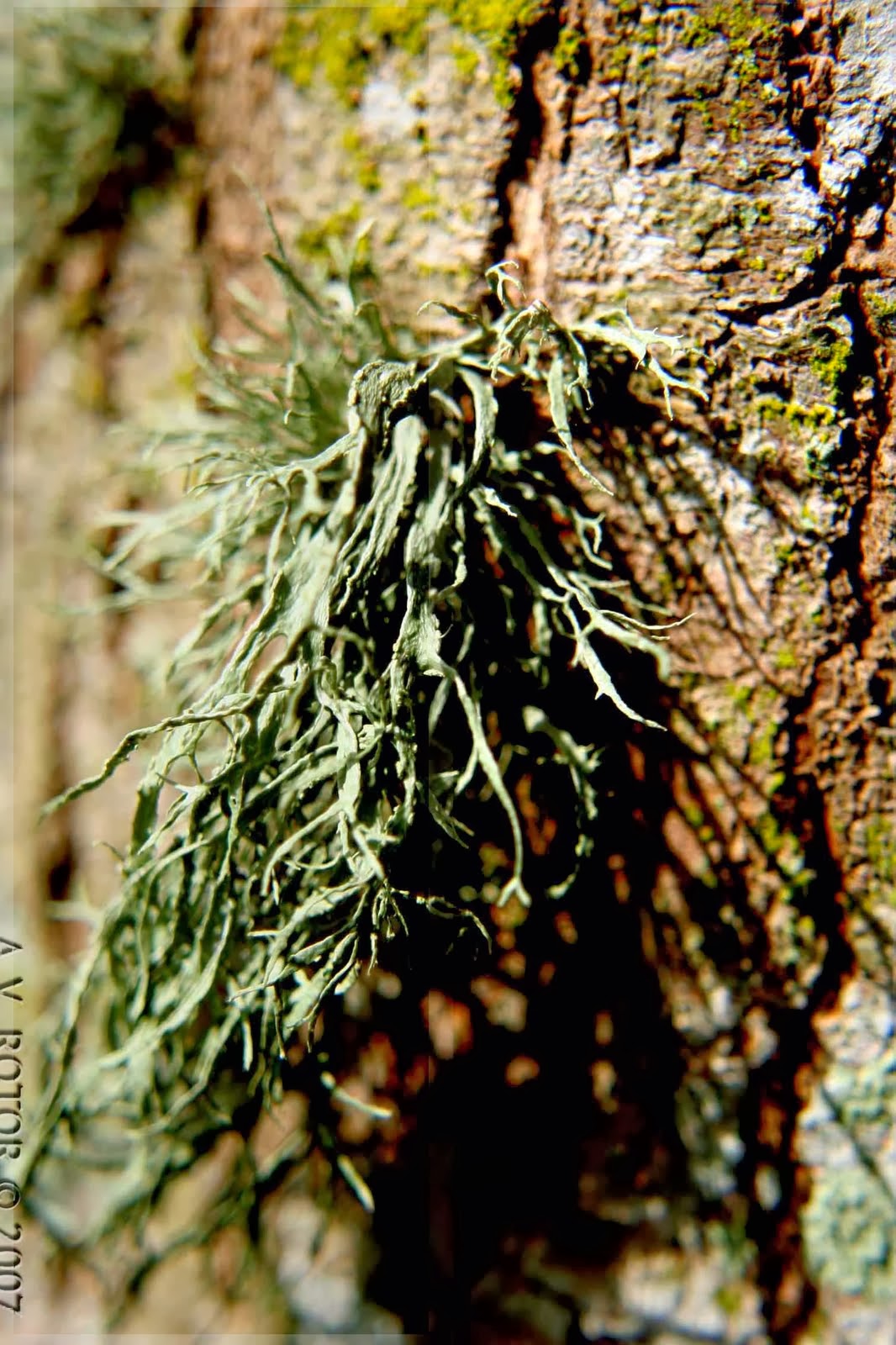Dr Abe V Rotor


Norfolk Pine in Tagaytay bears on its trunk a carpet of Foliose and Squamous Lichens which are mistaken at first glance as a disease or parasite.
The fact is, lichens play a symbiotic role with the host tree, a relationship whereby the lichens gain foothold that enable them to reach out for the sun and to occupy space with least competition with other organisms. One the other hand, the tree is protected from pest and effects of environmental change like drought.
The fact is, lichens play a symbiotic role with the host tree, a relationship whereby the lichens gain foothold that enable them to reach out for the sun and to occupy space with least competition with other organisms. One the other hand, the tree is protected from pest and effects of environmental change like drought.
The lichen in itself is an interesting specimen. A lichen is actually a group of two distinct genera of different kingdoms in the phylogeny of living organisms - alga (Kingdom Protista) and fungus (Kingdom Mycophyta) or in other cases bluegreen (Cyanophyta, Kingdom Monera) - living inseparably, a relationship developed through the long and uncertain process of evolution.
Instead of each member developing its own adaptation, the two joined forces so to speak, in order for both to survive. It is a perfect example of evolution through
cooperation, instead of competition as in most cases of evolutionary success.
The alga being photosynthetic manufactures food which it shares with the fungus. The fungus on the other hand, being saprophytic, converts organic matter back into elemental forms which the alga again uses. Such a relationship consists of an enduring cycle - season in season out, year in year out, covering a span of hundreds if not a thousand years. Such a feat is among the wonders of the living world. If the
Redwood or Sequioa is the longest living individual which is estimated to be up to three thousands years, the lichen is the longest living union (mutualism).
cooperation, instead of competition as in most cases of evolutionary success.
The alga being photosynthetic manufactures food which it shares with the fungus. The fungus on the other hand, being saprophytic, converts organic matter back into elemental forms which the alga again uses. Such a relationship consists of an enduring cycle - season in season out, year in year out, covering a span of hundreds if not a thousand years. Such a feat is among the wonders of the living world. If the
Redwood or Sequioa is the longest living individual which is estimated to be up to three thousands years, the lichen is the longest living union (mutualism).
The key to such success through mutualism lies not only in highly efficient nutrient exchange, but gas exchange principally CO2 and O2, as well. More so, for their ability to transform rocks into living mass which they share with other living things in their own time and in the future. They are the precursors of succession in the living world. Which points out to another evolutionary tool - benevolence - the sharing of resources albeit destructive competition.
More than this general knowledge there is very little we know about lichens. One thing ecologists are learning about lichens is the fact that they are a natural indicator, a sort of barometer, of environmental conditions. They thrive best where the air is clean, temperature change is moderate, so with relative humidity, the vegetative cover undisturbed, the rivers and lakes full, etc. And that lichens thrive best where man's intervention is least - if ever there is.
Yet lichens are found in the most difficult areas like the Arctic and desert, on rock cliffs, even dilapidated and abandoned structures. Their resistance as well as vulnerability to changing environment has led scientists to use the lichen as a biological indicator.
It leads us to the simple philosophy of a old man living near the summit of Mt Pulag in Benguet, reminiscent of the American philosopher Henry David Thoreau who lived by a pond (Walden Pond) deep in a woodland far away from town.
Yet lichens are found in the most difficult areas like the Arctic and desert, on rock cliffs, even dilapidated and abandoned structures. Their resistance as well as vulnerability to changing environment has led scientists to use the lichen as a biological indicator.
It leads us to the simple philosophy of a old man living near the summit of Mt Pulag in Benguet, reminiscent of the American philosopher Henry David Thoreau who lived by a pond (Walden Pond) deep in a woodland far away from town.
Here on the country's second highest mountain, 'Tang Ben, when asked on how Nature is kept pristine - even without first explaining to him the scientific basis of diversity and balance - simply quipped with confidence and sparkle in his eyes.
"Just leave Nature alone."
---------------------------------------Lichens: Enduring symbiosis of algae and fungi living as one complex organism
Lichens are indicators of clean air, in the order of increasing pristine condition:
crustose, foliose, fruiticose.
How do you rate the place you are living in?

Crustose lichen with juvenile fruticose lichen (branching)
--------------------------------------------------------
It has been estimated that 6% of the Earth's land surface is covered by lichen. Lichens are informally classified by growth form into:
· crustose (paint-like, flat), e.g., Caloplaca flavescens
· filamentous (hair-like), e.g., Ephebe lanata
· foliose (leafy), e.g., Hypogymnia physodes
· fruticose (branched), e.g., Cladonia evansii, C. subtenuis, and Usnea australis
· leprose (powdery), e.g., Lepraria incana
· squamulose (consisting of small scale-like structures, lacking a lower cortex),
e.g., Normandina pulchella
· gelatinous lichens, in which the cyanobacteria produce a polysaccharide that absorbs
· gelatinous lichens, in which the cyanobacteria produce a polysaccharide that absorbs
and retains water.



No comments:
Post a Comment